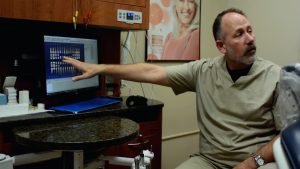Orthodontic care looks different today thanks to advances in technology. AI in Orthodontics is changing how treatment is planned, monitored, and completed. It helps orthodontists predict tooth movement, speed up planning, and improve results using data-driven tools. This shift makes care more precise and gives patients a clearer path toward a better smile.
What Is AI in Orthodontics?

AI in orthodontics refers to the use of computer systems that can analyze data, recognize patterns, and make predictions. In orthodontic care, AI helps with diagnosis, treatment planning, and monitoring progress. These tools use algorithms trained on thousands of patient cases to predict how teeth will move and which methods will deliver the best outcomes.
This doesn’t replace orthodontists. It supports their work by providing more detailed analysis and helping them decide on the most effective course of action. Think of it as a high-powered assistant that never gets tired and always bases its recommendations on a wide pool of reliable data.
How AI Helps in Diagnosis
Accurate diagnosis is key to good orthodontic care. AI tools can scan digital impressions, X-rays, and 3D models of the mouth to detect issues like crowding, gaps, and bite problems. They do this quickly and consistently.
In many cases, AI software spots small details that may be missed by the human eye. It can also compare a patient’s data to thousands of similar cases, offering insights on how certain treatments worked for others. This helps orthodontists create a plan that fits the patient’s unique dental structure.
Smarter Treatment Planning
AI has changed how orthodontists build treatment plans. Traditional methods required manual measurements, visual inspections, and time-consuming model analysis. AI speeds this up by generating digital simulations of different treatment options.
These simulations show how the teeth are likely to move over time. Orthodontists can compare different approaches and choose the one with the best balance of speed, comfort, and outcome. For teens and adults who prefer Invisalign, AI helps map out every step of aligner movement before the treatment even begins.
Better Predictions with Machine Learning
Machine learning is a type of AI that learns by studying data. In orthodontics, this means the system gets smarter over time. As more patients go through treatment, the software keeps track of their progress and compares it to predicted outcomes. This feedback loop helps refine future treatment suggestions.
For example, if a certain tooth takes longer to shift than expected, the system can update its model for similar cases. That leads to better predictions, fewer adjustments, and smoother treatment for future patients.
Faster Turnaround Times
AI speeds up every stage of treatment. Digital scans, powered by AI, allow orthodontists to skip traditional impressions that take longer and often feel uncomfortable for patients. Once the scans are complete, the software quickly generates treatment plans and simulations.
This cuts down waiting time and helps patients start their treatment sooner. Many practices that use AI tools report shorter planning phases and fewer revisions during treatment.
Improved Monitoring and Adjustments
AI isn’t just helpful at the start of treatment. It also plays a role in tracking progress. Some AI systems can analyze regular photos taken by the patient at home. These photos are compared to the predicted tooth movements, and the system can alert the orthodontist if something isn’t going as planned.
This allows the provider to make changes early, before small issues become big problems. Patients don’t always need to come into the office as often, which saves time and money for both the orthodontist and the patient.
Increased Accuracy with 3D Imaging
3D imaging and AI work well together. When paired, they create a detailed model of the patient’s teeth, jaw, and facial structure. This helps the orthodontist see how different treatments will affect not just the teeth, but also the appearance of the face and bite.
AI software uses these 3D models to run simulations, so orthodontists can view the expected results before starting treatment. It also helps them spot hidden issues that traditional X-rays might miss.
Boosting Patient Confidence
Many patients feel anxious about wearing braces or aligners. AI tools help them feel more confident by showing them exactly what to expect. Before treatment starts, patients can view a digital preview of their future smile. This visual approach builds trust and gives them a reason to stick with the plan.
Parents also like seeing proof that the treatment will work. AI gives them the information they need to feel confident in the care their child is receiving.
Supporting Clear Aligner Technology
Invisalign and other clear aligner systems rely heavily on AI. Each set of aligners is custom-made to move teeth gradually. AI helps design each step of this process. It maps out how each tooth should move, when to apply pressure, and how long each aligner should be worn.
This makes clear aligners a practical option for patients who want something more discreet. Patients looking for Invisalign in Bethesda can benefit from providers who use AI-based systems to plan and track aligner progress.
Saving Time for Orthodontists
Orthodontists often manage many patients at once. AI helps lighten that load. Tasks like analyzing scans, checking for tooth movement, and measuring jaw alignment take less time when AI is involved. That gives orthodontists more time to focus on patient care and less time doing repetitive tasks.
It also allows them to treat more patients without lowering the quality of care. Practices that use AI tools report higher productivity and better time management.
Data-Driven Decisions
AI tools don’t guess. They analyze large amounts of data to back every recommendation. This creates a more reliable treatment plan based on what works best in similar cases. That makes it easier to identify problems early and reduce the need for course corrections later.
Why AI Doesn’t Replace the Orthodontist
AI is a tool. It doesn’t replace skill, training, or good judgment. Orthodontists use AI to enhance their work, not to give up control. The human touch still matters when it comes to understanding a patient’s needs, setting goals, and making final decisions.
Orthodontists must also decide which AI tools to trust, how to apply their suggestions, and when to make adjustments. AI helps with speed and accuracy, but the orthodontist still runs the show.
Looking Ahead
AI will likely continue to grow in orthodontics. As the technology improves, systems will become even faster and smarter. More offices will adopt AI-powered tools for daily use. Patients will benefit from shorter treatments, better outcomes, and more predictable results.
Practices that combine experience with modern tools offer strong value to families looking for quality care. Those searching for an orthodontist in Bethesda may find that AI plays a big role in choosing a practice that delivers precise results.
A Practice That Uses Smart Tools for Real Results
With Dr. Jonathan A. Morris D.D.S., P.C., we focus on precision, comfort, and efficiency. Our team uses advanced digital tools, including AI-based technology, to plan and guide orthodontic treatment. We work with both braces and clear aligners, including options for teens and adults.
Patients feel confident knowing we use proven systems and clear communication to deliver results they can see. We take time to explain treatment steps, answer questions, and create a plan that works for each smile.
Families considering braces in Bethesda can trust our practice to provide care that fits today’s standards while keeping each visit personal and productive.
Schedule Your Consultation
Ready to begin your orthodontic journey? Schedule a consultation with Dr. Jonathan A. Morris today. We’ll walk you through your options and build a customized treatment plan that suits your lifestyle and goals.
Final Thoughts
AI is helping orthodontists raise the standard of care. It speeds up planning, improves accuracy, and allows orthodontists to focus more on patients and less on paperwork. With AI in orthodontics, outcomes are clearer, timelines are shorter, and treatment is easier to manage.
FAQs
How is AI used in orthodontics?
AI helps orthodontists create treatment plans, track tooth movement, and predict outcomes more accurately. It analyzes data from 3D scans, X-rays, and digital impressions to guide decision-making. This improves planning speed and reduces the need for frequent manual adjustments.
Does AI replace the orthodontist?
No. AI supports the orthodontist’s work but does not replace their judgment or experience. It provides additional insights and helps streamline tasks, but all decisions still come from the orthodontist.
Can AI help with clear aligners?
Yes. AI plays a major role in planning and tracking clear aligner treatment. It maps each step of tooth movement, helping aligners fit better and work more efficiently. Patients considering Invisalign in Bethesda can benefit from practices that use AI tools for aligner planning.
Is AI used with traditional braces?
AI can also improve the experience for patients with traditional braces. It helps design bracket placement and monitor tooth progress between visits. Patients getting braces in Bethesda may notice better accuracy and shorter treatment times when AI is part of the process.




